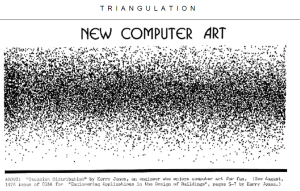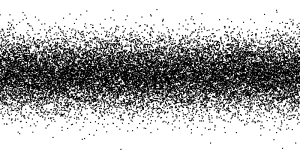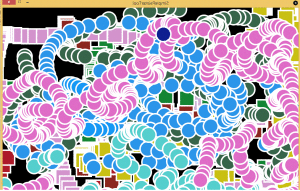For my final project I made a two-player running race game.
Author: Miha Klasinc
Computational Media
Computational media have, in the very least, increased the possibilities of expression, reception of information and interaction.
Arduino // Processing
I made a project wherein a push button connected to Arduino controls the size of a pair of circles in Processing.
Spectre
I saw the new James Bond movie this weekend and decided to do a simple visualization of the text featured in the official teaser for Spectre.
Gaussian distribution
I am a psychology major and thus encounter Gaussian distributions quite a lot. That is why I decided to recreate Terry Jones’s piece entitled – you guessed it – “Gaussian distribution”.
Terry Jones: “Gaussian Distribution”
Miha Klasinc: “Terry Jones’s Gaussian Distribution”
Processing facilitated my job quite a lot since it provided me with a built-in Gaussian distribution function. The function outputs a number following standardized normal distribution. This means that there is a roughly 68% probability that the outputted number is within one standard deviation (i.e. 1 unit) away from the mean 0, a 95% probability that the number is within two standard deviations away from the mean etc. If the function is called a number of times (e.g. 10000 times), a relatively uniform distribution of values clustered around the mean emerges. I created a for loop that calls the Gaussian distribution function 20000 times. Upon each iteration, a small circle is created. The first circle’s X coordinate is set to 1 and then increases by 1 with each iteration. If the X value exceeds the limits of the canvas the X coordinate is set back to 0. The circles’ Y coordinates are determined by the addition of outputted random numbers to half of the canvas’ size. This results in circles being distributed around the line that splits the canvas into two equal halves.
Here’s the code:
int xCoordinate = 1;
int canvasHeight = 400;
float middleLine = canvasHeight/2;
void setup() {
size(800, 400);
background(255);
}
void draw(){
stroke(0);
fill(0);
}
void GaussianDistr(){
for(int i = 0; i < 20000; i++){
float y = randomGaussian() * 50;
ellipse(xCoordinate,middleLine+y,2,2);
xCoordinate++;
if(xCoordinate >= width){
xCoordinate = 0;
}
println(xCoordinate);
redraw();
}
}
void mousePressed() {
GaussianDistr();
redraw();
saveFrame("GaussianDistribution.png");
}
Drawing tool
I made a simple drawing tool that can be used to make drawings with colorful circles and squares.
Rat movement
Stupid Pet Trick
For the Stupid Pet Trick, I made an electric toothbrush whose movements are controlled by a touch sensor.
Door Switch 2.0
For my first Intro to IM assignment I made a door switch that turns on the LED when the door gets open. For my third assignment, I expanded the original circuit by incorporating a photo sensor that renders the mechanism more robust and friendlier to all parties involved.
Dining etiquette training
My mother always told me not to rest my arms on the table while eating. Although I never saw the merits of such a behavior, I did not object to her mandate and have been careful about where I placed my arms while sitting at the table ever since. Nowadays, table manners seem to have lost their significance. Yet it is never too late to learn some dining etiquette! For my Second Intro to IM assignment, I made an electrical circuit that identifies improper table manners. If only arm rests on the table, a yellow LED lights up, warning the user of her potential transgression. If, however, both arms rest on the table, both red and yellow LED’s start flashing. This is a clear signal to the user to move his arms off the table.




